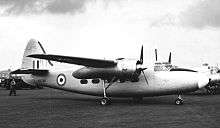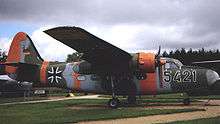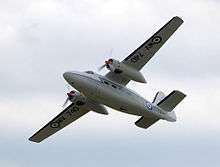Percival Pembroke
| Percival P.66 Pembroke | |
|---|---|
 | |
| Privately owned Hunting Percival P.66 Pembroke C.1 takes off in 2008 | |
| Role | Light transport |
| Manufacturer | Percival Aircraft Company |
| First flight | 21 November 1952 |
| Introduction | 1953 |
| Retired | 1988 |
| Primary user | Royal Air Force |
| Produced | 1953-1958 |
| Number built | 128 |
|
| |
The Percival Pembroke was a British high-wing twin-engined light transport aircraft built by the Percival Aircraft Company, later Hunting Percival.
Development
The Pembroke was a development of the Percival Prince civil transport. It had a longer wing to permit a higher fully laden weight. The prototype flew on 21 November 1952. Production was complete in early 1958.
Operational history

It entered service with the Royal Air Force as the Percival Pembroke C.1 in 1953 to replace the Avro Anson for light transport duties. As with other RAF transports, the passenger seats are rearward-facing for improved safety.
Six were produced as the Pembroke C(PR).1 photographic reconnaissance aircraft. These saw use by No. 81 Squadron RAF during the Malayan Emergency. The RAF's Pembrokes were modified to extend their lifespan in 1970. The last unit to use them was No. 60 Squadron RAF based at RAF Wildenrath in Germany, these were withdrawn from use in 1988 and were replaced by the Hawker Siddeley Andover.
The Finnish Air Force operated two aircraft for aerial photography between 1956 and 1968, on behalf of the National Land Survey of Finland. One of the aircraft was destroyed when it hit a snow wall during landing in 1965. The other aircraft is currently stored at the Aviation Museum of Central Finland.[1]
Variants
- P.66 Pembroke C.1
- Communications and transport variant for the RAF, 44 built.
- P.66 Pembroke C(PR).1
- Photographic reconnaissance variant for the RAF, six built and two conversions from C.1.
- P.66 Pembroke C.51
- Export variant for Belgium.
- P.66 Pembroke C.52
- Export variant for Sweden. Swedish military designation Tp 83.
- P.66 Pembroke C.53
- Export variant for Finland.
- P.66 Pembroke C.54
- Export variant for West Germany.
- P.66 Pembroke C.55
- Export variant for Sudan.
- P.66 President
- Civil transport version, five built.
Operators

- Belgian Air Force operated 12 C.51s from 1954 to 1976.
- South Rhodesian Air Force operated two C.1 aircraft diverted from Royal Air Force contract.
- Royal Air Force operated 56 aircraft delivered from 1953.
- Empire Test Pilots' School
Survivors

- Pembroke C.1 WV740 (G-BNPH) is privately maintained in RAF markings in the UK (as of 2009) and gives flying displays.
- Pembroke C.1 WV746 is currently housed in Hangar 1 at RAF museum Cosford. Ex CinC's Air Support Command VIP personal aircraft of 1960's and 1970's. Modified to carry wheelchair ramp. Later with 60 Squadron in Germany.
- Pembroke C.51 s/n K66-B4001 is located at the Essex County Airport in Fairfield, New Jersey. The aircraft was built in 1953 and last served with the Belgium Air Force. The left engine is inoperable and the aircraft is damaged and in a deteriorated condition. It was offered as a warbird contest prize in spring 2009.
- Pembroke C.51 s/n K66-4002 is on display at Taylor's Stateline Liquor Store in Neelyville, MO.
- Belgian Air Force keeps its RM7 at their Melsbroek premises just across the military air terminal; its sister RM4 is in the Brussels Aviation Museum.
- Classic Air Force at Coventry Airport, England operate Pembroke C.1 G-BXES painted as XL954 in RAF Transport Command Livery.
- Pembroke SE-BKH (ex RAF XK884) is at Västerås Flygmuseum, Sweden, in airworthy condition with Swedish markings.
- Pembroke C.52/Tp 83, Swedish Flygvapnet 83007 is displayed at Svedinos Bil- och Flygmuseum, Ugglarp, Halland, Sweden.[2][3]
- Pembroke C.54s 54+21 and 54+24 are at Flugausstellung Hermeskeil, Rheinland Pfalz, Germany.[4]
- Pembroke C.54 54+08 is on display at Aeronauticum, adjacent to Nordholz Naval Airbase, Germany.[5]
- Pembroke C.54 54+02 is displayed at Sinsheim Auto & Technik Museum, Germany, marked as "D-CAKE".[6]
- Pembroke C.54 AS+558 / 54+07 is displayed at Militärhistorisches Museum Flugplatz Berlin-Gatow, Germany.[7]
Specifications (Pembroke C.1)

Data from Gatwick museum Pembroke page
General characteristics
- Crew: two pilots
- Capacity: eight passengers
- Length: 46 ft (14.02 m)
- Wingspan: 64 ft 6 in (19.66 m)
- Height: 16 ft (4.9 m)
- Empty weight: 9,961 lb (4,400 kg)
- Max. takeoff weight: 13,489 lb (6,124 kg)
- Powerplant: 2 × Alvis Leonides 127 9-cylinder supercharged radial piston engines, 540 hp (410 kw) each
Performance
- Maximum speed: 186 mph (300 km/h)
- Range: 1,012 nm (1,850 km)
- Service ceiling: 7,680 m (22,000 ft)
See also
- Aircraft of comparable role, configuration and era
- Related lists
References
Notes
- ↑ Keskinen et al.: Suomen museolentokoneet p. 48, (1981), Forssa, Tietoteos, ISBN 951-9035-60-5
- ↑ http://www.svedinos.se/flygmuseum/
- ↑ http://www.smb.nu/index.php/svenska-flygplan/transportflygplan/672
- ↑ http://www.flugausstellung.de/flugzeuge.html
- ↑ http://www.flugzeugforum.de/bw-kennungen-seit-1968-a-62214-7.html
- ↑ http://www.flugzeug-bild.de/name/einzelbild/number/50922/kategorie/Kleinflugzeuge~Historische~Sonstige.html
- ↑ http://www.museum-digital.de/berlin/index.php?t=objekt&oges=933
Bibliography
- The Illustrated Encyclopedia of Aircraft (Part Work 1982-1985) London: Orbis Publishing, 1985.
- Jackson, A.J. British Civil Aircraft since 1919 (Volume 3). London: Putnam, 1974. ISBN 0-370-10014-X.
- Jefford, Wing Commander C.G., MBE, BA, RAF (Retd). RAF Squadrons, a Comprehensive Record of the Movement and Equipment of all RAF Squadrons and their Antecedents since 1912. Shrewsbury, Shropshire, UK: Airlife Publishing, 2001. ISBN 1-84037-141-2.
- Sturtivant, Ray, ISO and John Hamlin. RAF Flying Training And Support Units since 1912. Tonbridge, Kent, UK: Air-Britain (Historians) Ltd., 2007. ISBN 0-85130-365-X.
External links
| Wikimedia Commons has media related to Percival Pembroke. |
- RAF museum
- Contemporary advert for Pembroke
- "Flight" 1954 cutaway drawing military mission roles